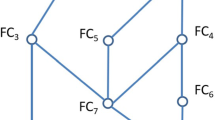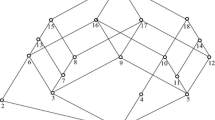Abstract
Granular reduction has been of great interests for formal context analysis. From the perspective of granular computing, granular matrices are proposed to represent the extensions and intensions of formal concepts. Within this framework, irreducible elements are studied. Furthermore, similarity degree, information granular and information entropy are developed to specify the significance of attribute. In this case, heuristic approaches for granular reduct are proposed. Finally, several data sets are experimented to demonstrate the feasibility and efficiency of our method. Our methods present a new framework for granular reduction in formal concept analysis.
Similar content being viewed by others
References
Belohlavek R, Baets BD, Konecny J (2014) Granularity of attributes in formal concept analysis. Inf Sci 260(1):149–170
Carpineto C, Romano G (1996) A lattice conceptual clustering system and its application to browsing retrieval. Mach Learn 24(2):95–122
Ch AK, Dias SM, Vieira NJ (2015) Knowledge reduction in formal contexts using non-negative matrix factorization. Math Comput Simul 109:46–63
Chen JK, Mi JS, Lin YJ (2018) A graph approach for knowledge reduction in formal contexts. KnowlBased Syst 148:177–188
Dias SM, Vieira NJ (2015) Concept lattices reduction: definition, analysis and classification. Expert Syst Appl 42(20):7084–7097
Dias SM, Vieira NJ (2017) A methodology for analysis of concept lattice reduction. Inf Sci 396:202–217
Davey BA, Priestley HA (2002) Introduction to lattices and order. Cambridge University Press, Cambridge
Deng W, Zhao HM, Yang XH, Xiong JX, Sun M, Li B (2017) Study on an improved adaptive PSO algorithm for solving multi-objective gate assignment. Appl Soft Comput 59:288–302
Deng W, Xu JJ, Zhao HM (2019) An improved ant colony optimization algorithm based on hybrid strategies for scheduling problem. IEEE Access 7:20281–20292
Fenza G, Senatore S (2010) Friendly web services selection exploiting fuzzy formal concept analysis. Soft Comput 14(8):811–819
Ganter BB, Wille R (1999) Formal concept analysis. Springer, Berlin
Huang CC, Li JH, Dias SM (2016) Attribute significance, consistency measure and attribute reduction in formal concept analysis. Neural Netw World 26(6):607–623
Huang CC, Li JH, Mei CL, Wu WZ (2017) Three-way concept learning based on cognitive operators: an information fusion viewpoint. Int J Approx Reason 83:218–242
Hao SF, Shi CY, Niu ZD, Cao LB (2018) Concept coupling learning for improving concept lattice-based document retrieval. Eng Appl Artif Intell 69:65–75
Kumar CA, Srinivas S (2010) Concept lattice reduction using fuzzy K-means clustering. Expert Syst Appl 37(3):2696–2704
Kang XP, Li DY, WangS S, Qu KS (2012) Formal concept analysis based on fuzzy granularity base for different granulations. Fuzzy Sets Syst 203:33–48
Kardos F, Pócs J, Pócsová J (2016) On concept reduction based on some graph properties. Knowl-Based Syst 93:67–74
Liu M, Shao MW, Zhang WX, Wu C (2007) Reduction method for concept lattices based on rough set theory and its application. Comput Math Appl 53(9):1390–1410
Li JH, Mei CL, Lv YJ (2011) A heuristic knowledge-reduction method for decision formal contexts. Comput Math Appl 61(4):1096–1106
Li JH, Mei CL, Lv YJ (2011) Knowledge reduction in decision formal contexts. Knowl-Based Syst 24(5):709–715
Li JH, Mei CL, Lv YJ (2012) Knowledge reduction in formal decision contexts based on an order-preserving mapping. Int J Gen Syst 41(2):143–161
Li JH, Mei CL, Lv YJ (2012) Knowledge reduction in real decision formal contexts. Inf Sci 189:191–207
Li JH, Xie B, Mi JS, Li MZ (2017) On the use of cut set for attribute reduction in L-fuzzy concept lattice. In: International conference on machine learning and cybernetics. IEEE, pp 323–330
Li JY, Wang X, Wu WZ, Xu YH (2016) Attribute reduction in inconsistent formal decision contexts based on congruence relations. Int J Mach Learn Cybern 8(1):1–14
Li KW, Shao MW, Wu WZ (2017) A data reduction method in formal fuzzy contexts. Int J Mach Learn Cybern 8(4):1145–1155
Lang GM, Miao DQ, Cai MJ, Zhang ZF (2017) Incremental approaches for updating reducts in dynamic covering information systems. Knowl-Based Syst 134:85–104
Li LF, Zhang DX (2019) 0–1 linear integer programming method for granule knowledge reduction and attribute reduction in concept lattices. Soft Comput 23(2):383–391
Martin TP, Rahim NHA, Majidian A (2013) A general approach to the measurement of change in fuzzy concept lattices. Soft Comput 17(12):2223–2234
Ma JM, Leung Y, Zhang WX (2014) Attribute reductions in object-oriented concept lattices. Int J Mach Learn Cybern 5(5):789–813
Ma JM, Cai MJ, Zou CJ (2017) Concept acquisition approach of object-oriented concept lattices. Int J Mach Learn Cybern 8(1):123–134
Qi JJ (2009) Attribute reduction in formal contexts based on a new discernibility matrix. J Appl Math Comput 30(1–2):305–314
Rajapakse RK, Denham M (2006) Text retrieval with more realistic concept matching and reinforcement learning. Inf Proces Manag 42(5):1260–1275
Shao MW, Leung Y, Wu WZ (2014) Rule acquisition and complexity reduction in formal decision contexts. Int J Approx Reason 55(1):259–274
Shao MW, Leung Y (2014) Relations between granular reduct and dominance reduct in formal contexts. Knowl-Based Syst 65:1–11
Shao MW, Leung Y, Wang XZ, Wu WZ (2016) Granular reducts of formal fuzzy contexts. Knowl-Based Syst 114:156–166
Tan AH, Li JJ, Lin GP (2015) Connections between covering-based rough sets and concept lattices. Int J Approx Reason 56:43–58
Valtchev P, Missaoui R, Godin R (2004) Formal concept analysis for knowledge discovery and data mining: the new challenges. In: International conference on formal concept analysis, Springer, Berlin, Heidelberg, pp 352–371
Wille R (1982) Restructuring lattice theory: an approach based on hierarachies of concepts. In: Rival I (ed) Oredered sets. Reidel, Dordrecht, pp 445–470
Will R (2005) Formal concept analysis as mathematical theory of concepts and concept hierarchies, Formal concept analysis, Ganter B et al, des., Springer-Verlag, pp 1–33
Wille R (2002) Why can concept lattices support knowledge discovery in databases? J Exp Theor Artif Intell 14(2–3):81–92
Wei L, Qi JJ, Zhang WX (2008) Attribute reduction theory of concept lattice based on decision formal contexts. Sci China Ser F Inf Sci 51(7):910–923
Wu WZ, Leung Y, Mi JS (2009) Granular computing and knowledge reduction in formal contexts. IEEE Trans Knowl Data Eng 21(10):1461–1474
Wei L, Qi JJ (2010) Relation between concept lattice reduction and rough set reduction. Knowl-Based Syst 23(8):934–938
Yang B, Hu BQ (2018) Matrix representations and interdependency on L-fuzzy covering-based approximation operators. Int J Approx Reason 96:57–77
Zhao HM, Liu HD, Xu JJ, Deng W (2019) Performance prediction using high-order differential mathematical morphology gradient spectrum entropy and extreme learning machine. IEEE Trans Instrum Meas 1–1
Zhang WX, Wei L, Qi JJ (2005) Attribute reduction in concept lattice based on discernibility matrix. International workshop on rough sets, fuzzy sets, data mining, and granular-soft computing. Springer, Berlin, pp 157–165
Zhang WX, Wei L, Qi JJ (2005) Attribute reduction theory and approach to concept lattice. Sci China Ser F Inf Sci 48(6):713–726
Acknowledgements
This work is supported by Grants from the National Natural Science Foundation of China (Nos. 11871259, 11701258 and 61379021 ).
Author information
Authors and Affiliations
Corresponding author
Ethics declarations
Conflict of interest
All authors declare that they have no conflict of interest.
Additional information
Communicated by V. Loia.
Publisher's Note
Springer Nature remains neutral with regard to jurisdictional claims in published maps and institutional affiliations.
Rights and permissions
About this article
Cite this article
Lin, Y., Li, J. & Wang, H. Granular matrix method of attribute reduction in formal contexts. Soft Comput 24, 16303–16314 (2020). https://doi.org/10.1007/s00500-020-04941-5
Published:
Issue Date:
DOI: https://doi.org/10.1007/s00500-020-04941-5




